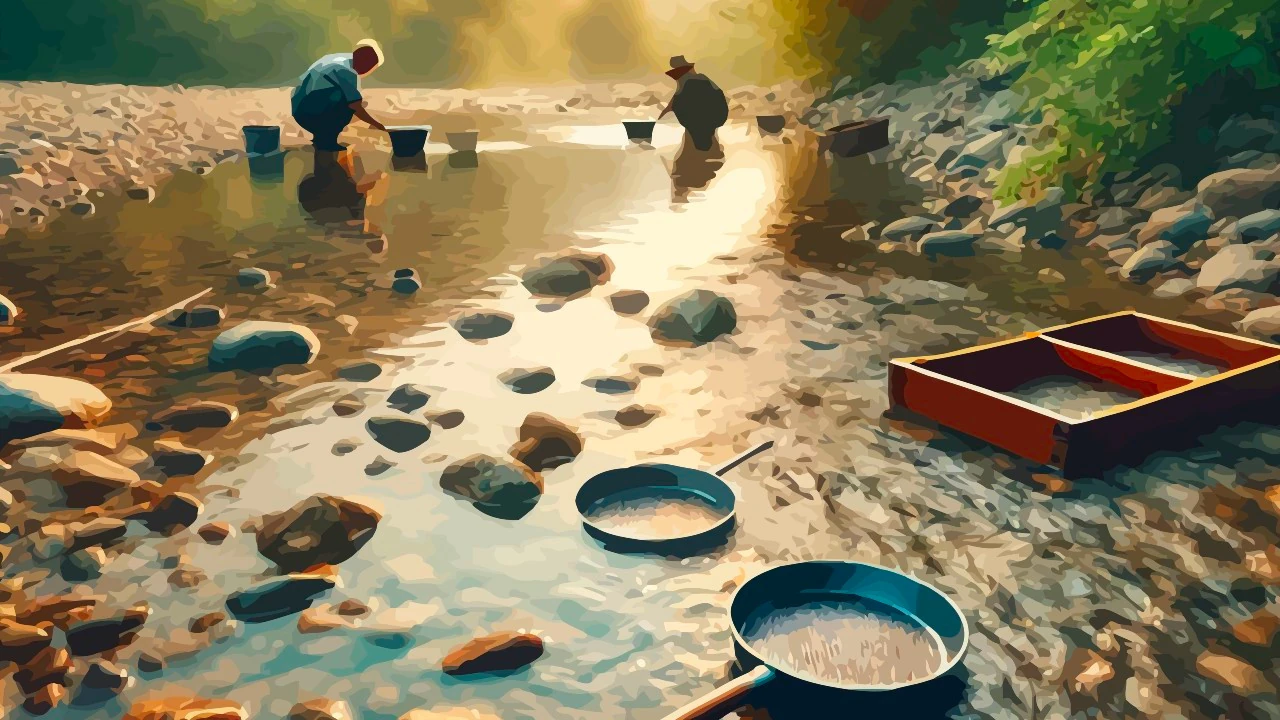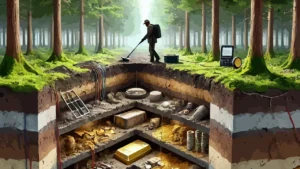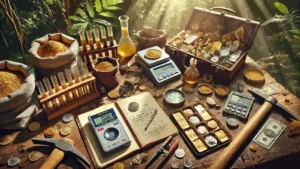Gold prospecting is an activity that has fascinated humanity for centuries. Today, finding gold in nature is still possible, but it requires knowledge, proper tools and a good dose of patience. In this guide, we will explore the most common methods, places and techniques for venturing in search of the precious yellow metal.
Contents
#1. Gold and its value
Gold is a precious metal prized for its beauty, ductility, and resistance to corrosion. Since ancient times, it has been used to create jewelry, coins, and decorative objects. But what makes gold so special? First, its rarity: gold is found only in small quantities in the Earth’s crust. Also, its brilliance and unique color distinguish it from other metals, making it one of the most desired materials in the world.
The history of gold is closely linked to human civilization. From the time of the ancient Egyptians, who considered it the “metal of the gods,” to the gold rushes of the 19th century, this metal has inspired dreams, ambitions, and conflicts. Today, despite technological evolution, its importance has not diminished: gold is used not only in jewelry, but also in electronics, medicine, and investments.
Finding gold in the wild can be an exciting and rewarding experience. However, it is not just about luck: knowing the right locations, the right techniques and having a methodical approach are essential to increasing your chances of success.
#2. Where is gold found in nature?
Gold is formed in specific geological conditions and is often found in two main forms: alluvial gold and primary gold. Alluvial gold is deposited in river beds and areas where water has eroded the surrounding rocks. This type of gold is easier to collect, as it comes in the form of flakes or nuggets. River beds, in particular, are ideal places for novice prospectors.
Primary gold, on the other hand, is trapped in quartz veins or other source rocks. This type of research requires more advanced techniques and often the use of specific tools to extract the metal from the rock. For example, traditional gold mines focus on these types of deposits, often located in mountainous or volcanic areas. Studying the geology of the area therefore becomes a key element in identifying the best sites.
Some of the most common places to find gold include:
- River and stream beds: Gold tends to settle in bends and places where the water slows down, forming small accumulations,
- Glacial deposits: Areas affected by ancient glaciers may contain alluvial gold mixed with sediments transported by the ice,
- Abandoned mines: Old mines may hide uncollected gold residues, especially at depth or in rock fractures,
- Volcanic areas: Gold is often associated with volcanic and thermal phenomena, where high temperatures favor the formation of gold-bearing veins.
Each place has its own peculiarities, and studying the geology of the area is essential to identify the best research sites. Furthermore, patience and perseverance are essential: gold is not always found at the first attempt, but every discovery, even a small one, is a great satisfaction for the prospectors.a costanza sono essenziali: non sempre l’oro si trova al primo tentativo, ma ogni scoperta, anche piccola, è una grande soddisfazione per i cercatori.
#3. Tools and techniques for searching
To find gold in nature, you need to have the right tools. Some of these are simple and accessible, while others require a larger investment. Each tool has a specific role and can be used depending on the type of search you intend to do. Here is a list of essential tools:
- Sifter and pan: ideal for searching for alluvial gold in rivers. These tools allow you to separate the gold from the sand and gravel through a manual washing process,
- Metal detector: useful for locating nuggets or metal deposits hidden in the ground. It is a versatile tool that can be used in both river and mountain areas,
- Geological hammer and chisel: essential for working on source rocks and for extracting samples of quartz or other gold-containing minerals,
- Water pumps and sluice boxes: to collect large quantities of sediment to be filtered. These tools are particularly useful in river environments, where the volume of material to be treated is greater,
- Separation table : to separate gold from other lighter minerals. This tool is very effective and is used mainly by experienced prospectors.
Search techniques vary depending on the type of gold being searched for. For alluvial gold, for example, the “panning” technique is very popular. It involves collecting sand and gravel from riverbeds and washing them in a pan, using a circular motion to separate the gold, which is heavier than other materials.
For primary gold, however, it is necessary to dig into the rocks and use more advanced methods, such as crushing and chemical treatment. Regardless of the technique chosen, it is important to gain experience in the field and learn from your mistakes. Practice is essential to hone your skills and increase your chances of success.
Additionally, it is advisable to start with simple equipment and gradually improve your equipment as you gain experience. This approach allows you to better understand the dynamics of research and optimize your available resources.
#4. Practical advice for beginners
If you are a beginner in the world of gold prospecting, there are some tips that can help you take your first steps in this fascinating activity. Preparation, knowledge of the territory and choosing the right tools are essential to start off on the right foot.
First, study the area. Learn about the geology of the area where you intend to search for gold. There are geological maps that indicate the most promising areas to find gold deposits. Riverbeds, old mines and volcanic areas are ideal starting points to begin your search.
Another important aspect is equipment. Make sure you have essential tools such as a pan, a panning tool, and if possible, a metal detector. These tools will help you identify and collect gold efficiently. Don’t forget to also carry water, food, and a first aid kit, especially if you are venturing into remote areas.
Start your search in small streams. Streams are often less frequented than larger rivers and may harbor gold nuggets or flakes. Look carefully at bends and areas where the water slows down, as gold tends to settle in these spots.
Another essential tip is to learn to recognize gold. This metal has a higher specific weight than other minerals and does not oxidize. Practice with small amounts to develop your ability to distinguish gold from other materials present in sediments.
Finally, keep a positive mindset and don’t get discouraged. Gold panning requires patience and dedication. You won’t always find immediate results, but every small success will be a great satisfaction. Remember that field experience is also an integral part of the learning process.
Join local gold panning groups or associations. Sharing your knowledge and experience with other enthusiasts can help you improve your techniques and discover new promising locations.
#5. Environment and regulations
Gold mining should always be done in an environmentally friendly manner and in compliance with local laws. This not only ensures a sustainable activity, but also protects you from any penalties or legal problems. Before you begin, find out about the regulations that govern mineral extraction in your area. In some countries, you need to obtain a specific license or permit to search for gold.
Avoid operating in protected areas, such as natural parks or reserves. These places are often subject to severe restrictions to preserve the ecosystem. Also, if you are on private land, make sure you have the owner’s permission before starting your search.
Another important aspect is the environmental impact. Use non-invasive techniques and limit the use of chemicals that can pollute the soil or water. For example, avoid excessive digging or diverting the course of rivers. Leave the area where you worked in the same state in which you found it, removing any waste or equipment.
Also respect other gold miners. Prospecting is an activity that can be shared, but it is important to avoid conflicts or overlaps in work areas. Maintaining a collaborative attitude can make the experience more enjoyable for everyone.
Finally, remember that the natural environment is a precious resource as gold itself. Preserving biodiversity and respecting the territory are the responsibilities of every prospector. An ethical approach not only protects the environment, but also helps to keep alive the beauty of the places you visit.
By following these guidelines, you can enjoy gold panning responsibly and sustainably, helping to preserve natural resources for future generations.
#6. Costs to search for 10 grams of gold
For an ordinary person, searching for 10 grams of gold is a task that involves significant costs in terms of both resources and time.
- Equipment:
- Basic set for manual research: pan, sieve, shovels. (Cost: 100-300 EUR),
- More advanced equipment, such as a metal detector. (Cost: 500-3,000 EUR),
- Permits: In many regions a permit is required for research. (Cost: 50-500 EUR),
- Transport and Logistics: Travelling to (often remote) gold-bearing areas can involve costs for fuel, accommodation and food. (Cost: 200-1,000 EUR/day),
- Time Spent: Manual gold panning is extremely time consuming. It can take a person weeks to find 10 grams, with an “opportunity cost” of lost earnings in other activities,
- Average yield: In rich gold areas, one can find between 0.1 and 1 gram of gold per day. To reach 10 grams, it might take a person 10-20 days, depending on luck and site conditions,
- Estimated total cost: Adding up all expenses, the overall cost of finding 10 grams of gold can vary between 1,000 and 5,000 EUR, depending on the equipment used and logistical costs.
Currently, 10 grams of pure gold costs almost 900 EUR on the market. This makes it clear that buying gold is often much cheaper than searching for it yourself, except where you have access to rich deposits or already available resources.bili.











Leave a Reply